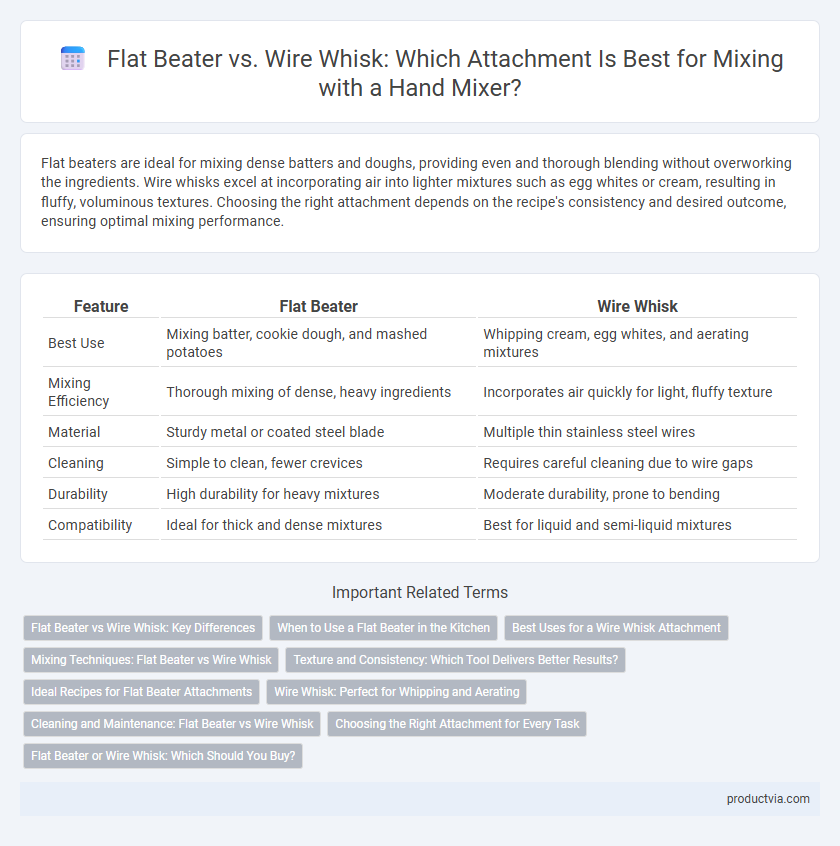Flat beaters are ideal for mixing dense batters and doughs, providing even and thorough blending without overworking the ingredients. Wire whisks excel at incorporating air into lighter mixtures such as egg whites or cream, resulting in fluffy, voluminous textures. Choosing the right attachment depends on the recipe's consistency and desired outcome, ensuring optimal mixing performance.
Table of Comparison
| Feature | Flat Beater | Wire Whisk |
|---|---|---|
| Best Use | Mixing batter, cookie dough, and mashed potatoes | Whipping cream, egg whites, and aerating mixtures |
| Mixing Efficiency | Thorough mixing of dense, heavy ingredients | Incorporates air quickly for light, fluffy texture |
| Material | Sturdy metal or coated steel blade | Multiple thin stainless steel wires |
| Cleaning | Simple to clean, fewer crevices | Requires careful cleaning due to wire gaps |
| Durability | High durability for heavy mixtures | Moderate durability, prone to bending |
| Compatibility | Ideal for thick and dense mixtures | Best for liquid and semi-liquid mixtures |
Flat Beater vs Wire Whisk: Key Differences
Flat beaters excel at mixing dense and heavy ingredients like cake batter and cookie dough, providing thorough blending and even texture. Wire whisks are designed for incorporating air into mixtures, making them ideal for whipping cream, egg whites, and light batter. Choosing between a flat beater and wire whisk depends on the desired texture and consistency of the mixture.
When to Use a Flat Beater in the Kitchen
A flat beater is ideal for mixing medium- to heavy-weight batters and doughs such as cake mixes, cookie dough, and mashed potatoes, where thorough but gentle mixing is required. It efficiently blends ingredients without incorporating excessive air, making it perfect for tasks that demand a smooth, even consistency. Use the flat beater when creaming butter and sugar, mixing dense mixtures, or preparing frostings that require a stable texture.
Best Uses for a Wire Whisk Attachment
A wire whisk attachment excels at incorporating air into light mixtures such as egg whites, whipped cream, and mousse, creating volume and a fluffy texture. Its numerous thin, flexible wires allow for rapid and efficient beating, making it ideal for aerating batters and emulsifying ingredients. Using a wire whisk ensures smooth and airy results, especially for delicate or thin mixtures requiring light incorporation rather than dense mixing.
Mixing Techniques: Flat Beater vs Wire Whisk
Flat beaters excel at combining heavier ingredients like cake batter and cookie dough, providing dense and thorough mixing with minimal splatter. Wire whisks incorporate air efficiently, ideal for whisking egg whites, cream, and light batters to achieve fluffy, airy textures. Choosing the correct attachment enhances mixing performance by matching the tool to ingredient consistency and desired end result.
Texture and Consistency: Which Tool Delivers Better Results?
Flat beaters create a denser and smoother batter ideal for cookies, cakes, and mashed potatoes by thoroughly combining ingredients without incorporating much air. Wire whisks excel at aerating mixtures such as egg whites and cream, producing lighter, fluffier textures due to their ability to incorporate more air. Choosing between a flat beater and wire whisk depends on the desired texture and consistency, with flat beaters delivering more uniform and thick results, while wire whisks ensure volume and lightness.
Ideal Recipes for Flat Beater Attachments
Flat beater attachments are ideal for mixing cookie dough, cake batters, and mashed potatoes due to their ability to thoroughly combine dense and thick ingredients without over-aerating. Unlike wire whisks, flat beaters ensure even mixing of heavy mixtures, preventing splattering and promoting uniform texture in recipes with moderate consistency. This makes them the preferred choice for batters that require a smooth blend without incorporating excessive air.
Wire Whisk: Perfect for Whipping and Aerating
Wire whisk attachments excel at whipping and aerating ingredients, incorporating air to create light, fluffy textures ideal for meringues, whipped cream, and mousse. Their thin, flexible wires efficiently break up mixtures and increase volume quickly compared to flat beaters. Choosing a wire whisk enhances the mixing process for recipes requiring delicate aeration and smooth consistency.
Cleaning and Maintenance: Flat Beater vs Wire Whisk
Flat beaters feature a smooth, solid design that resists food buildup, making cleaning straightforward and less time-consuming compared to wire whisks. Wire whisks have multiple thin wires that can trap batter and ingredients, requiring more thorough scrubbing and careful drying to prevent rusting. Opting for a flat beater reduces maintenance efforts due to its simpler construction and easier rinsing under running water.
Choosing the Right Attachment for Every Task
Flat beaters excel at mixing heavy batters, cake dough, and cookie mixtures by providing thorough blending and minimal air incorporation. Wire whisks rapidly incorporate air, making them ideal for whipping egg whites, cream, and creating light, fluffy textures. Selecting the appropriate attachment based on ingredient density and desired texture ensures efficient mixing and optimal baking results.
Flat Beater or Wire Whisk: Which Should You Buy?
The flat beater is ideal for mixing heavy batters, cookie dough, and mashed potatoes due to its sturdy, broad design that ensures thorough blending without over-aerating. The wire whisk excels at incorporating air into lighter mixtures like egg whites, whipped cream, and mousse, creating fluffy, voluminous textures. Choosing between the flat beater and wire whisk depends on the type of recipes you frequently prepare, with the flat beater favored for dense ingredients and the wire whisk for aerated, delicate mixtures.
Flat beater vs Wire whisk for mixing Infographic

 productvia.com
productvia.com